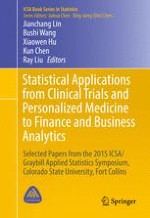2016 | OriginalPaper | Buchkapitel
Personalized Effective Dose Selection in Dose Ranging Studies
verfasst von : Xiwen Ma, Wei Zheng, Yuefeng Lu
Erschienen in: Statistical Applications from Clinical Trials and Personalized Medicine to Finance and Business Analytics
Aktivieren Sie unsere intelligente Suche, um passende Fachinhalte oder Patente zu finden.
Wählen Sie Textabschnitte aus um mit Künstlicher Intelligenz passenden Patente zu finden. powered by
Markieren Sie Textabschnitte, um KI-gestützt weitere passende Inhalte zu finden. powered by
